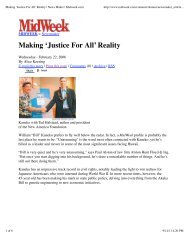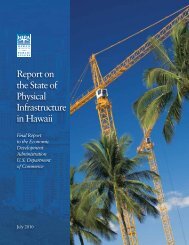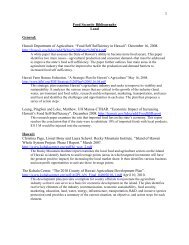Hawai'i Fisheries Initiative - The Hawaii Institute for Public Affairs
Hawai'i Fisheries Initiative - The Hawaii Institute for Public Affairs
Hawai'i Fisheries Initiative - The Hawaii Institute for Public Affairs
You also want an ePaper? Increase the reach of your titles
YUMPU automatically turns print PDFs into web optimized ePapers that Google loves.
and the ali‘i nui; harvests also were used in<br />
trade with other ahupua‘a. <strong>The</strong> konohiki,<br />
relying on experts who were versed in the<br />
habits and biology of the fish of nearby waters,<br />
managed the ahupua‘a’s coastal fisheries<br />
through a sophisticated kapu system, rules<br />
based on conservation principles, religion,<br />
and personal interest. Kapu (prohibitions)<br />
may be placed on harvesting a fish during<br />
its spawning season, <strong>for</strong> example. 493 Such<br />
private ahupua‘a fishing rights (also referred<br />
to as konohiki fishing rights) extended to<br />
the point where the reef meets the deep<br />
ocean, and in places where there was no<br />
reef, to one mile seaward. 494<br />
Fishponds: Near-Shore<br />
Private <strong>Fisheries</strong><br />
Native <strong>Hawaii</strong>ans built and used loko i‘a,<br />
as well as ocean nets and baskets, in their<br />
successful aquaculture practices, both <strong>for</strong><br />
freshwater and marine fish. <strong>The</strong>re is evidence<br />
that fishponds were constructed as early as<br />
1000 A.D. through the early 1800s. 495<br />
In 1903, approximately 2,000 fishponds<br />
produced more than 660,000 pounds<br />
of fish. 496 In 1993 (the most recent total<br />
count), DLNR’s State Historic Preservation<br />
Division reported 488 fishponds in varying<br />
states of disrepair scattered throughout<br />
the six major islands, with rehabilitation<br />
ef<strong>for</strong>ts focused on 74 ponds on Moloka‘i. 497<br />
Rehabilitation continues privately and<br />
publicly, some lured by potential economic<br />
gain from fish, shrimp, or seaweed sales,<br />
and others <strong>for</strong> cultural revival. For example,<br />
the Office of <strong>Hawaii</strong>an <strong>Affairs</strong> grants funds<br />
to support reconstruction and maintenance<br />
ef<strong>for</strong>ts of fishponds, such as a $99,000<br />
grant in 2007 <strong>for</strong> reconstruction of a<br />
fishpond wall at Kaloko-Honokohau<br />
National Historic Park and $87,570 in 2004<br />
<strong>for</strong> a “classroom without walls” at the<br />
Kuapa ahupua‘a and fishpond. 498<br />
99







